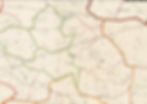Are you using maps in your Irish research?
- moughty
- May 21, 2018
- 4 min read
Updated: Dec 29, 2018

I’m always amazed when people aren’t using maps. I had a person tell me one time that they planned to visit a cousin who lived just outside of Dublin. When I asked where, thinking they would say Wicklow or Meath, the answer was Donegal! Have you looked at a map? Ireland is not a big place…you can drive from end to end in a day. But when you’re trying to figure out which individual of the same name is your ancestor, locations are important and maps can help. I frequently say that our ancestors didn’t move around a lot, but they might have moved just a short distance into another townland, or, if they were on the border of a parish or even county, they might have slipped over the border. That’s why maps are important.
When I’m researching I begin with Brian Mitchell’s New Genealogical Atlas of Ireland. I saw a poor review of this which said “it’s just maps.” Well, yes, that’s usually what an Atlas is. It shows you the county borders (so you know that Dublin is not near Donegal). For each county there are maps showing the borders of the parishes, the baronies (used for Griffith’s), the dioceses of the Church of Ireland (important for pre-1858 wills), Poor Law Unions (which became the civil registration districts), probate districts (for post-1858 wills), ecclesiastical parishes for the Roman Catholic Church and Presbyterian congregations in the nine counties of Ulster. That’s a lot of maps. I make a copy of the parish map and draw on it to show where families are located in Griffith’s Valuation. When you have a number of families with the same surname, this is one way to divide them up into families. Given names in Griffith’s can also be a clue based on Irish naming patterns. If there are a number of given names that have passed down in your family, it may indicate a relative. In the example above, Peter, Laurence and Andrew were not names that passed down in the family, whereas Francis, Patrick and John were in each generation. If you’re still trying to discern a locality, the parishes where those names appear would be an area for focus.
If you can’t find the records of your family in the Roman Catholic parish church where you expect them perhaps they attended a closer church in a neighboring parish. Roman Catholic parishes were frequently larger and might encompass multiple civil parishes. Another site I use for maps is John Grenham’s IrishAncestors. The town of Dundalk is on the East coast of Ireland in County Louth. I was searching for a baptismal record in the late 1700s in the civil parish of Kane in the northern part of the county. There were multiple records for individuals of the same name, and I initially ignored the record in Dundalk, thinking it was too far away…until I looked at the Roman Catholic parish map. Dundalk Roman Catholic parish included multiple civil parishes all the way up to the border with Armagh.

Townland maps are sometimes hard to find. I search the name of the parish with the words “townland map" and look at the images. Sometimes I’m lucky and can find the map. Ros Davies has a wonderful site for County Down with lots of records and maps. She has hand drawn townland maps for each parish. As I was putting together my cluster research on the Moag family this was critical to assigning individuals to the correct family based on their locations.

If you can’t find a townland map, you can create one by using the Ordnance Survey Ireland maps. For the six counties of Northern Ireland, you can use the Historical Map Viewer at on the PRONI website. I searched for the parish, took a screen shot and marked in the townland names.

You can do something similar for the Republic of Ireland using the Ordnance Survey Ireland Public Viewer. In this case I drew the boundaries of the parishes in manually (shown in green) to highlight the locations of interest.

If you have identified your ancestors in Griffith’s Valuation, the sites have maps showing the location of the holding. AskAboutIreland uses a later map, but is unique in that you can do an overlay of a contemporary maps to identify where the property is located now (in case you want to visit). The base map shows the holding from the OSI historical maps, and my family in Ballycrune was on lot 14. By overlaying a contemporary map (and adjusting the opacity) I can see that the property is on the current Ballanahinch Road, across from the Fortwilliam Country House.

Another way you might want to use contemporary maps is to determine the distance between two points. This can be helpful when looking at the likelihood that two locations are close enough for our ancestors to walk in the 19th century. Would your ancestor have courted someone who lived 20 miles or more away? Under what circumstances would they have met? I sometimes use Google Maps to determine a distance. It will typically give me the driving distance, but you can also look at the walking route, which typically would be shorter, across the fields. Here’s an example of driving from the Fortwilliam Country House to the Loughaghery Presbyterian Church where my ancestors were baptized. It says it 1.4 miles and it would take 4 minutes. I’ve driven this and perhaps a local could make it in 4 minutes, but the road to the church is curvy and only wide enough for one car. It took me a lot longer!

As you research your family, also research the locality using maps. It just may help you break through your brick wall.
Happy Hunting!
I’ll be at the Southern California Genealogy Jamboree from May 31 to June 2. If you’re going to be there, don’t forget to introduce yourself.